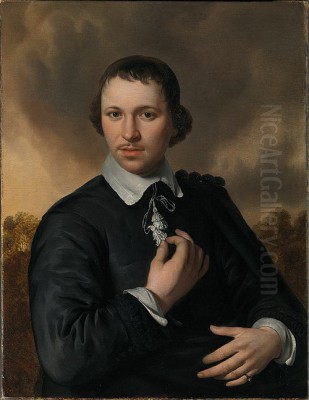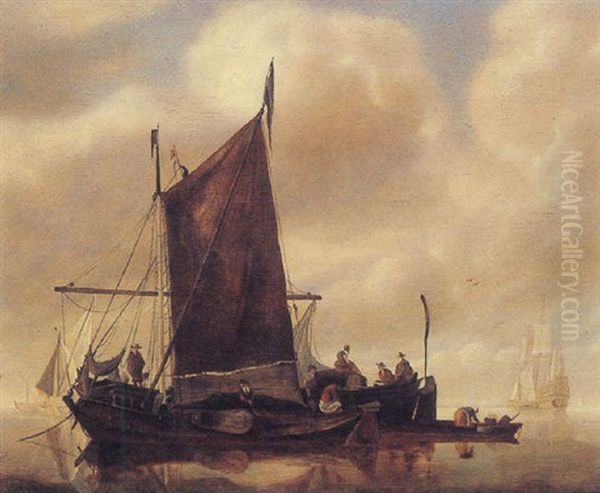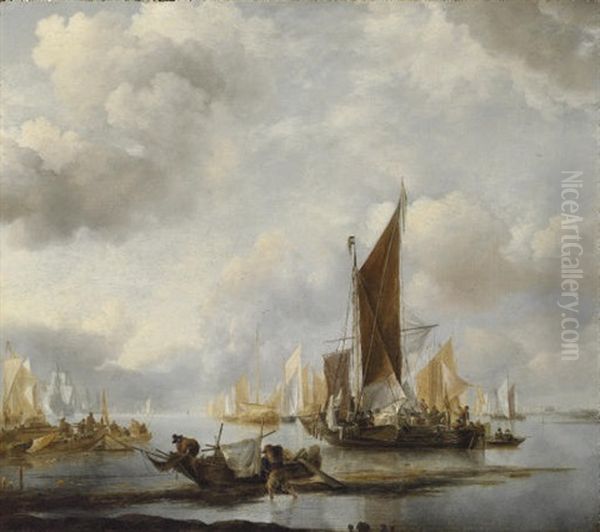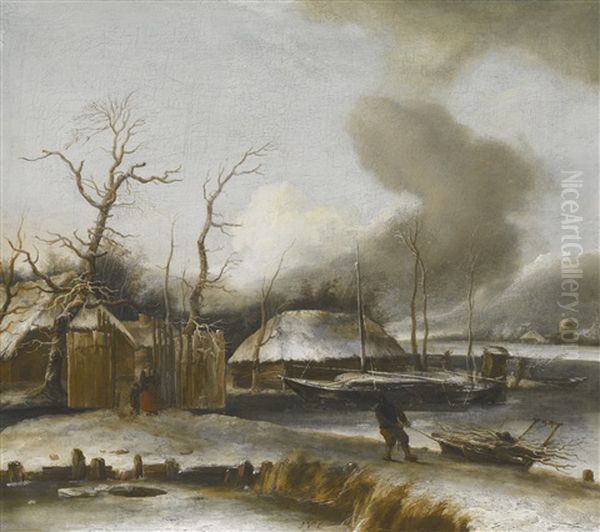
The 17th century in the Netherlands, often referred to as the Dutch Golden Age, was a period of extraordinary artistic efflorescence. Amidst a galaxy of brilliant painters specializing in various genres, marine painting rose to prominence, reflecting the young republic's dependence on and mastery of the seas. Within this specialized field, Jan van de Cappelle stands out as a unique and highly esteemed figure, a master of serene seascapes whose life and work offer a fascinating glimpse into the world of a wealthy connoisseur who painted for pleasure rather than necessity.
A Life of Affluence and Artistic Passion
Jan van de Cappelle was born in Amsterdam, likely between 1624 and 1626, into a prosperous family. His father, Franchoys van de Cappelle, owned a successful dye-works, a business that Jan, along with his brother Louis, would eventually inherit and manage. This substantial inheritance provided him with considerable wealth and financial independence throughout his life. He was baptized in the Nieuwe Kerk in Amsterdam on January 25, 1626.
Unlike many of his contemporaries who underwent rigorous apprenticeships and joined the Guild of Saint Luke (the painters' guild) to practice their profession, Van de Cappelle remained an amateur in the truest sense of the word. He was largely self-taught, though his work shows a profound understanding of and debt to the leading marine painters of his time, particularly Simon de Vlieger. His privileged financial position meant he did not need to paint for a living, allowing him the freedom to develop his style and choose his subjects without the pressures of the art market or specific commissions dictating his output. He married Annetje Jansdr. Grotingh in 1653, and the couple had several children. Van de Cappelle passed away in his native Amsterdam and was buried in the Nieuwe Kerk on December 22, 1679.
The Art of Serenity: Style and Thematic Focus

Jan van de Cappelle is celebrated primarily for his tranquil and atmospheric marine paintings. His canvases typically depict calm waters, often estuaries, river mouths, or sheltered harbors, under vast, luminous skies. He was a master of capturing the subtle interplay of light and atmosphere, rendering the silvery sheen of water, the soft diffusion of sunlight through clouds, and the delicate reflections of ships and sky on the water's surface with remarkable skill.
His palette was often characterized by cool, silvery tones, with subtle gradations of grey, blue, and muted earth colors, contributing to the overall sense of peace and harmony that pervades his work. While some marine painters, like Ludolf Bakhuizen, specialized in dramatic storms and shipwrecks, Van de Cappelle preferred moments of quietude. His ships – often fishing boats, yachts, and occasionally larger state vessels – are usually depicted at anchor or gliding gently across placid waters. The human figures in his paintings are typically small, serving to animate the scene and provide scale rather than being the primary focus.
A distinctive feature of Van de Cappelle's compositions is his meticulous attention to the rigging and structure of the ships, betraying a keen interest and knowledge of seafaring vessels. He owned his own yacht, which he likely used for excursions along the Dutch waterways, providing him with firsthand observation opportunities for his art. This personal connection to the maritime world undoubtedly informed the authenticity and detail in his depictions.
Beyond his signature calm seas, Van de Cappelle also produced a smaller number of exquisite winter landscapes. These scenes, often featuring frozen canals or rivers with skaters and sleighs, share the same atmospheric sensitivity and delicate handling of light found in his marine works. They evoke a similar sense of stillness and the crisp, clear air of a winter's day.
Masterpieces of Light and Water
While Van de Cappelle's oeuvre is not as extensive as that of some of his professional contemporaries – with around 150 to 200 paintings attributed to him – it contains numerous masterpieces that exemplify his unique vision.

One of his most characteristic and celebrated types of composition is exemplified by works often titled Ships in a Calm or Calm Sea. These paintings, such as the one famously sold at Sotheby's, showcase his ability to create a profound sense of space and tranquility. Typically, a few vessels are carefully arranged in the foreground or middle ground, their sails either furled or loosely hanging, reflecting perfectly in the mirror-like water. The sky, often occupying a significant portion of the canvas, is filled with soft, voluminous clouds that catch the light, creating a gentle, diffused illumination across the scene.
Another important compositional type he developed is the "parade of ships" or "salute," sometimes referred to by the Dutch term De File. An excellent example is A Salute to a States Yacht, where numerous vessels, including an ornate states yacht, are gathered, perhaps for a ceremonial occasion. Even in these more populated scenes, Van de Cappelle maintains an overriding sense of order and calm. The arrangement of the ships is carefully considered, creating a harmonious balance and leading the viewer's eye through the composition. These works highlight the pride and importance of Dutch maritime power and civic life.
His Winter Landscape paintings, though fewer in number, are equally accomplished. They often depict wide, frozen expanses under pale winter skies, populated by figures enjoying the ice. Like his seascapes, these works are imbued with a quiet poetry and a masterful rendering of atmospheric conditions.
A Harbor with Reflecting Water is another title that encapsulates a common theme, where the reflections of boats, buildings, and the sky on the still water become a central element of the composition, demonstrating his fascination with the optical effects of light.
Influences, Contemporaries, and Artistic Circle
Jan van de Cappelle's artistic development was significantly shaped by the work of Simon de Vlieger (c. 1601–1653), one of the most innovative marine painters of the preceding generation. De Vlieger was a pioneer in the move towards more atmospheric and tonal seascapes, breaking away from the more colorful and detailed style of earlier marine artists like Hendrick Cornelisz Vroom. Van de Cappelle absorbed De Vlieger's lessons in rendering light, air, and calm water, and some of his earlier works are very close in style to his mentor. Indeed, it is believed that Van de Cappelle may have acquired a large number of De Vlieger's drawings after his death.

While primarily self-taught, Van de Cappelle was by no means isolated from the vibrant artistic community of Amsterdam. His wealth and status as a connoisseur brought him into contact with many leading artists. Remarkably, he had his portrait painted by at least three of the greatest masters of the age: Rembrandt van Rijn (1606–1669), Frans Hals (c. 1582/83–1666), and Gerbrand van den Eeckhout (1621–1674), a pupil of Rembrandt. The existence of these portraits by such eminent artists attests to Van de Cappelle's standing within artistic and social circles.
His own work, in turn, influenced subsequent marine painters. Artists like Hendrick Dubbels (1621–1707) and the celebrated Willem van de Velde the Younger (1633–1707) show the impact of Van de Cappelle's serene compositions and his treatment of light and atmosphere. Willem van de Velde the Elder (c. 1611–1693), father of the Younger, was another prominent contemporary marine specialist, known for his detailed "pen paintings."
Other notable marine painters of the era whose work provides context for Van de Cappelle's include Jan Porcellis (c. 1580/84–1632), who was instrumental in developing the tonal style in seascapes, and Ludolf Bakhuizen (1630–1708), whose dramatic and often stormy seas offer a contrast to Van de Cappelle's prevailing calm. Aelbert Cuyp (1620–1691), though known for a wider range of subjects including pastoral landscapes, also painted tranquil river scenes with a similar sensitivity to golden light that resonates with Van de Cappelle's atmospheric concerns. Even the great landscape painter Jacob van Ruisdael (c. 1628/29–1682) occasionally turned his hand to seascapes, often with a more dramatic or melancholic mood.
The Discerning Collector
Beyond his own artistic pursuits, Jan van de Cappelle was one of the most important art collectors of his time. His posthumous inventory, compiled after his death in 1679, reveals an astonishing collection that underscores his deep engagement with the art of his contemporaries and predecessors.
The inventory listed nearly 200 paintings and over 7,000 drawings by a host of celebrated artists. Most famously, he owned an unparalleled collection of drawings by Rembrandt, numbering around 500 sheets. This alone would mark him as a collector of exceptional taste and discernment. His collection also included paintings and drawings by Simon de Vlieger (as mentioned, he owned nine paintings and over 1,300 drawings by him), Hendrick Avercamp (known for his winter scenes), Jan van Goyen (a prolific landscape painter), Hercules Segers (an experimental printmaker and painter), and many other Dutch and Flemish masters.

This activity as a collector is crucial to understanding Van de Cappelle. It demonstrates that his involvement with art was profound and multifaceted. He was not merely a gentleman dilettante dabbling in painting; he was a serious connoisseur with a deep appreciation for artistic quality and innovation. His own painting practice was likely enriched by this constant immersion in the works of other masters. The wealth that allowed him to build such a collection also afforded him the leisure to perfect his own art without commercial constraints.
Later Years and Enduring Legacy
Information about Van de Cappelle's later life suggests a possible decline in his artistic output. Some scholars speculate that challenges in the family dye-works business, perhaps exacerbated by the economic downturn following the "Rampjaar" (Disaster Year) of 1672 when the Netherlands was invaded by France and its allies, may have required him to dedicate more time to commercial affairs.
Despite his amateur status and relatively limited production, Jan van de Cappelle's impact on Dutch marine painting was significant. His emphasis on atmosphere, his masterful depiction of calm waters and luminous skies, and his refined, poetic sensibility offered a distinct alternative to the more narrative or dramatic tendencies in marine art. He perfected a vision of the Dutch seascape as an "idyll," a harmonious interplay of water, sky, and human activity.
His influence extended beyond his immediate contemporaries. In the 19th century, as Dutch Golden Age painting was rediscovered and re-evaluated, Van de Cappelle's work found new admirers. The British Romantic painter J.M.W. Turner (1775–1851), himself a supreme master of light and atmosphere in marine subjects, is known to have studied and admired Dutch seascapes, and echoes of Van de Cappelle's tranquility and subtle light effects can be discerned in some of Turner's calmer marine pieces.
Van de Cappelle in Museum Collections and the Art Market
Today, Jan van de Cappelle's paintings are held in high esteem and can be found in major museum collections around the world, including the Rijksmuseum in Amsterdam, the National Gallery in London, the Mauritshuis in The Hague, and the Metropolitan Museum of Art in New York, among others. His work Retour des bateaux de pêche (Return of the Fishing Boats) has been associated with the Durand-Ruel gallery, a prominent dealership.
His paintings command significant prices when they appear on the art market, a testament to their rarity and enduring appeal. A notable example is a version of A Calm Sea, which achieved a remarkable £800,000 at a Sotheby's auction in 1998, far exceeding its estimate. The same, or a similar, painting reportedly sold for an even higher price of £1.7 million in another sale, underscoring the strong demand for his finest works. These auction records reflect the art world's continued appreciation for his unique contribution to marine painting.
A Master of Quietude
Jan van de Cappelle occupies a special niche in the history of art. He was a wealthy businessman who painted not for fame or fortune, but for the love of art itself. His financial independence allowed him to pursue his personal vision, resulting in works of extraordinary beauty and refinement. As a painter, he captured the serene majesty of the Dutch waters and skies with a sensitivity to light and atmosphere that few could rival. As a collector, he assembled one of the most impressive collections of his time, demonstrating his profound understanding and appreciation of his fellow artists.
His legacy is one of quiet mastery. In a world often drawn to drama and spectacle, Van de Cappelle's paintings are odes to tranquility, inviting contemplation and offering a timeless vision of peace and harmony on the water. He remains a pivotal figure in Dutch Golden Age marine painting, a testament to the power of art pursued with passion and discernment. His works continue to enchant viewers with their subtle beauty and their evocative portrayal of the unique maritime landscape of the Netherlands.